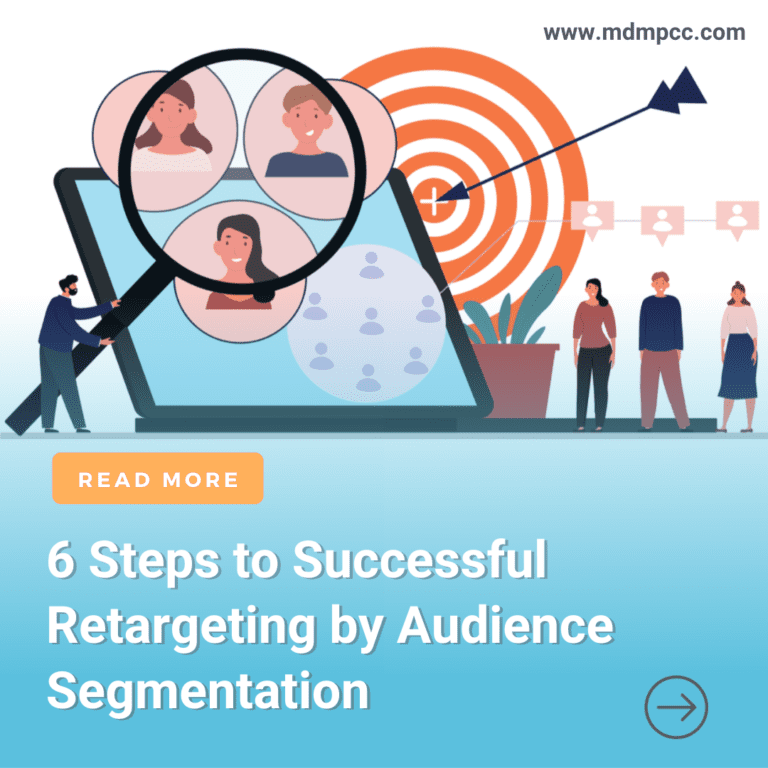Audience segmentation is the master key to successful retargeting.
If your retargeting campaigns aren’t performing as well as you’d like, it’s likely that your segmentation needs to be improved. The biggest retargeting mistake a marketer can make is assuming that all visitors are the same and serving the same ads to all of them. Your results will be poor if you don’t segment your visitors into pools. It makes no sense, for example, to show a banner ad for home decor to a user who has visited a page about shampoo.
By incorporating retargeting into your digital advertising campaigns, you can ensure that you remain visible throughout their purchasing process.
Retargeting has a great impact on conversions. So much so that when a prospect sees a retargeting ad, they’re 70% more likely to buy your product than your competitor’s. Retargeted visitors are 43 percent more likely to convert, says a CMO report.
Segmenting audiences allows you to recognize and understand the various tendencies and intentions of your site’s visitors. This is critical because you’ll be able to aggressively target users with relevant ad messages, customizing their retargeting experience.
So far, you must’ve realized that we will be focussing on this key aspect of retargeting- that is, audience segmentation.
But let’s break down terms like retargeting and audience segmentation into easily digestible knowledge.
What is Retargeting?
Retargeting, which you otherwise know as remarketing, is a type of digital advertising that helps to show ads to visitors who previously visited your website but left without making any purchase.
It’s a crowded market with a plethora of choices for your prospective customer. If you don’t stay top of mind during the buying process, you can quickly lose conversions.
Retargeting is a type of online advertising that allows you to keep your ads in front of bounced visitors after they’ve left your site.
Mostly, on their first visit to your website, your potential customers will not convert. It’s a lot to expect. However, retargeting allows you to take advantage of time and presence to pique their interest, get in front of your competitors, and convert them into a customer.
Generally, only 2% of visitors to your website will convert on their first visit. Retargeting is a technique for reaching 98% of website visitors who don’t convert right away.
What is audience segmentation?
Segmentation or audience segmentation refers to people who are being targeted and served ads.
It is the process of categorizing audiences based on a set of shared characteristics such as demographics, purchasing habits, and so on. It’s advisable to focus on a specific audience based on the data you’ve gathered rather than showing your ads to everyone.
You can effectively retarget users in different stages of the purchase funnel by using audience segmentation to tailor ad messages to them.
Segmentation is crucial if you want to maximize the number of potential customers who are further along in the buying process. A potential customer who went to your checkout page but didn’t buy is worth a lot more than someone who just came to your homepage.
There has recently been a shift away from generic display ads and toward more granular retargeting strategies, which allow advertisers to reach their target audience with pinpoint accuracy.
Look at these examples:
- Visitors scrolling specific webpages
- Social media activities
- Reaching particular conversion pages
- Search terms used
- Buying behavior
While the list goes on, you get the idea. With so many options for segmenting your audience, you can create highly targeted campaigns that increase conversions while lowering ad costs.
8 Ways to do Audience Segmentation for Successful Retargeting
1. Consider Recency and Frequency
It’s crucial to consider frequency and recency when creating custom audiences. Frequency refers to the number of times each of the specified events should have occurred, whereas recency refers to the number of days or the range of days during which the user has performed specific actions. These two factors can assist advertisers in gauging user interest, creating segments based on events, and setting budgets wisely based on these insights.
Users who came to your site 5 hours ago and looked at a product are more likely to convert than those who came 15 days ago. The first step is to segment your visitors, but this must be done in conjunction with a lookback window.
It’s worthwhile to experiment with different hours and days because it can make a significant difference in ROI.
2. User-focussed rather than channel focussed
Change the channel-based mindset and focus on users to open endless possibilities.
Keep in mind that people use various platforms for various reasons. LinkedIn users, for example, will most likely be looking for job information, whereas Pinterest users will be looking for home remodeling tips and buying guides.
Setting up Facebook prospecting and retargeting campaigns is a good place to start.
But why are you limiting it to that?
Why not take it a step further and create a user list based on your traffic sources?
This is something that Google Analytics should be able to assist you with. Open Google Analytics and go to All traffic > Source > Medium Campaign.
Source: socialmediaexaminer.com
You can scroll down to view the list of traffic sources of your site.
Re-engage users across Google Display Network, YouTube, and other properties to expand your reach. Visitors who clicked on your email or were channeled to your site through an affiliate site can be reached by the same method.
The goal is to get retargeted users to see your advertising or ads on ad platforms and channels.
3. Reach your competitor’s users
It’s likely that your competitors have the same users you are trying to reach as your target audience if you really know them to be your competitors.
They don’t always follow up or keep in touch with users who have clicked on their ads. If your ad appeals to their users, they will click on it and purchase your product or service.
Shares or conversion shares are most likely how your competitors evaluate their campaigns. Few people even bother to look beyond that.
There’s nothing wrong with a marketer flirting with their target market. If they engage, keep interacting with them to see if you can persuade them to come to your store.
You can use Remarketing Lists for Search Ads (RLSA) to retarget visitors who have been to your website but are still searching for the same query in search engines.
4. Retarget users who have concerns in the purchase stage
It’s likely that your competitors have the same users you are trying to reach as your target audience if you really know them to be your competitors.
They don’t always follow up or keep in touch with users who have clicked on their ads. If your ad appeals to their users, they will click on it and purchase your product or service.
Shares or conversion shares are most likely how your competitors evaluate their campaigns. Few people even bother to look beyond that. There’s nothing wrong with a marketer flirting with their target market. If they engage, keep interacting with them to see if you can persuade them to come to your store.
You can use Remarketing Lists for Search Ads (RLSA) to retarget visitors who have been to your website but are still searching for the same query in search engines.
5. Use synchronous messaging and storytelling
Your ad campaign should never be like a one-dimensional interaction. But many marketers do otherwise and it’s a mistake.
Every ad should be a new chapter in your overall ad campaign as if it was a story.
You can’t just nudge deals and discounts without any context because the user won’t know what you’re saying. Your message should be in a logical order, with each ad building on the previous until you reach the point where conversion is desired.
In the same way, you can’t expect people to give a damn about a product or feature if they don’t understand it. Make sure the ads are named in the correct order. Ad2 should, for example, come after ad1 and ad3 should come after ad2.
People tend to scroll past advertisements that are irrelevant to them, so make each narrative you tell count.
6. Buyer Personas for Retargeting
It’s difficult to discuss audience segmentation without bringing up buyer personas. That’s because the two ideas are inextricably linked.
Personas, on the other hand, can be a tricky task. Personas are difficult to create, refresh, and maintain because few people have the time or resources to do so.
But all you need right now is a general understanding of your target audience’s online activities and needs (as they pertain to the product or service you’re selling). Users can now be identified using Google Analytics based on their gender, age, location, language, interests, and other characteristics.
With that information, you can create powerful ads that are relevant to their needs, resulting in higher conversion rates and sales for your company.
You can generate positive results with your retargeting campaigns by strategizing and taking the time to evaluate the required budget to reach each segment.
More than that, you’ll create a good experience for your brand.
Let us know how your attempt goes!





